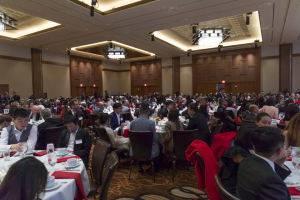A Historical Guide to China and Chinese Immigration to Cincinnati – Pt. 1
China’s recorded history began some four-thousand years ago. Three dynasties preceded the unification of China in 221 BCE: Xia (2070 BCE), Shang (1600 BCE), Zhou (1046 BCE). The Zhou period is a time of flourishing civilization. Writing was codified and iron work became more sophisticated. China saw the rise of philosophers such as Confucius and Lao-Zi (Taoism) in this period.
During the mid-Zhou dynasty, power was decentralized and China entered what is known as the “Spring and Autumn Waring Period” (722-221 BCE). Sun-Zi and The Art of War emerged during this time. China was fractured into seven kingdoms. In 221 BCE, the Kingdom of Qin subdued the other six and proclaimed its king, Ying Zheng, the First Emperor of China – “Qin ShiHuang.”
During Qin ShiHuang’s reign, writing and measurements were unified under a single system; government rule was centralized; trade was made easier by uniformed currency and standardized width of cart-wheels. Qin-ShiHuang was also famous for building the first section of The Great Wall of China and his “Terracotta Army” which accompanied him to his tomb.
Many dynasties followed Qin. Most notably the Tang Dynasty, which was known as China’s golden age (618-907 AD); the Song Dynasty, which saw great scientific and technological advancements (960-1279 AD); and Ming Dynasty, which saw the completion of the Great Wall and the Forbidden City (1368-1644 AD). The last dynasty of China, Qing, was ruled by the Manchus and ended in 1911. The Qing dynasty was succeeded by China’s modern republic age and eventually saw the rise of the People’s Republic of China in 1949.
During the Qing dynasty in 1868, the United States and China entered into the Burlingame Treaty. This treaty established formal relationship between the two countries. China was granted “most favored nation” status and immigration was encouraged. The first wave of Chinese immigrants arrived in the United States between the 1850s to 1880s. They mostly settled along the coasts (in California or New York). Most Chinese immigrants were labors working to build railroads.
In the 1870s, there were repeated efforts to limit Chinese immigration to the United States. The Fifteen Passenger Bill of 1879 limited the number of Chinese passengers to 15 in any single voyage to the United States. President Rutherford B. Hayes vetoed the bill because it violated the terms of the Burlingame Treaty.
Following the veto, President Hayes sent James Burrill Angell to China and he successfully negotiated a new treaty allowing restrictions on Chinese immigration. Following the Angell Treaty of 1880 was the passage of the infamous Chinese Exclusion Act of 1882. This Act was not repealed until 1943 under the Magnuson Act. Following the repeal, a second wave of Chinese immigrants to the US began from the late 1970s to the present.
The first Chinese migrants in Ohio were mostly descendants of Chinese immigrants who had settled on the West Coast. A majority of them moved to northeastern Ohio (Cleveland area). Some came to Cincinnati and made this region their home.
According to a local new paper report of the Census Bureau account, there were 17 Chinese living in Cincinnati in 1910 (“SEVENTEEN CHINESE: And Seven Japanese Lived in Cincinnati in 1910, Report Says.” SPECIAL DISPATCH TO THE ENQUIRER, Nov 28, 1914).
However, as early as 1894, the Cincinnati Enquirer reported Chinese New Year Celebration by about 30 Chinese men led by a laundry shop owner Sam Kee (“‘SUN NIN,’: The Chinese New-Year’s Day, Celebrated By Cincinnati Celestials with Much Eclat.” Cincinnati Enquirer, Feb 6, 1894).
In 1876, the first Chinese American reportedly voted in Cincinnati. (“The First Chinese Voter.” Cincinnati Enquirer, Apr 4, 1876).
In 1912, the Enquirer reported the first woman and child immigrant moving to Cincinnati (“CHINESE: Wife and Child Coming To Take Up Their Residence in Cincinnati – Similar Distinction May Be Given Covington.” Cincinnati Enquirer, Sep 26, 1912).
In 1914, the Cincinnati Enquirer reported the first Chinese Baby born here to Mr. and Mrs. Wong Yie at their Vine Street restaurant (“CHINESE BABY, First To Be Born in Cincinnati, Is Christened Wong Gut Ting in Fathers Home.” Cincinnati Enquirer, Jun 8, 1914).
Thousands more immigrate to Cincinnati to work or attend school. There are more than a dozen active Chinese community organizations in this region doing all sorts of charitable work. Most notably, the Greater Cincinnati Chinese Chamber of Commerce, the Cincinnati Chinese Society, the Chinese American Association of Cincinnati, the Cincinnati Chinese Church, and the Cincinnati Chinese Culture Learning Association.

Today, thousands of Chinese descendants call the Greater Cincinnati region their home.
The blog is in part of the Mission Continues blog series, written by Jin Kong and therefore all words and thoughts are his own and not a reflection of GCWAC.


